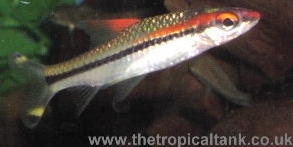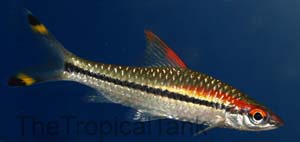

Photos © Sean Evans
|
| Common name: | Red Line Torpedo barb, Denison barb, Red Line Barb, Red Comet barb, Indian Roseline barb, "Miss Kerala" |
| Scientific name: | Sahyadria denisonii |
| Synonyms: | Puntius denisonii, also Barbus, Crossocheilus and Labeo denisonii (not valid) |
| Size: | 4" (10cm) |
| Origin: | Southern India |
| Recommended tank size: | 120 x 38cm (48 x 15") or larger. |
| Tank setup: | A spacious tank with plenty of swimming space, robust plants such as Anubias and Java Fern could be included. Keep water well oxygenated with a good flow rate. |
| Compatibility: | Keep with other lively community species, such as other medium-sized barbs and rainbowfish. |
| Temperature: | 18-25oC (64-77oF) |
| Water chemistry: | Fairly soft to slightly hard, around neutral (pH 6.5-7.5). |
| Feeding: | Omnivorous, most foods accepted, so feed a varied diet. This could include frozen foods and granular/flake foods, ideally including a vegetable component such as Spirulina.
Foods containing astaxanthin may help to intensify the red colouration. Soft-leaved plants may be eaten. |
| Sexing: | No obvious differences in juveniles, but adult females have a heavier body shape and may be less colourful than males. |
| Breeding: | Has been bred commercially, probably using hormone stimulation, but very few reports of aquarium breeding -
some indication that larger groups are required and softer water may help to trigger spawning. |
| Comments: |
A very striking barb species, which is now becoming more available in the aquarium trade (partly due to captive breeding), although
it is considered endangered in the wild. A second, very similar species, S. chalakkudiensis, has also been described.
|





